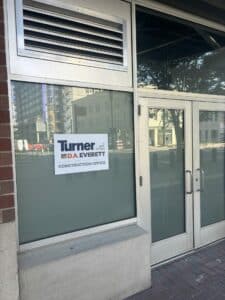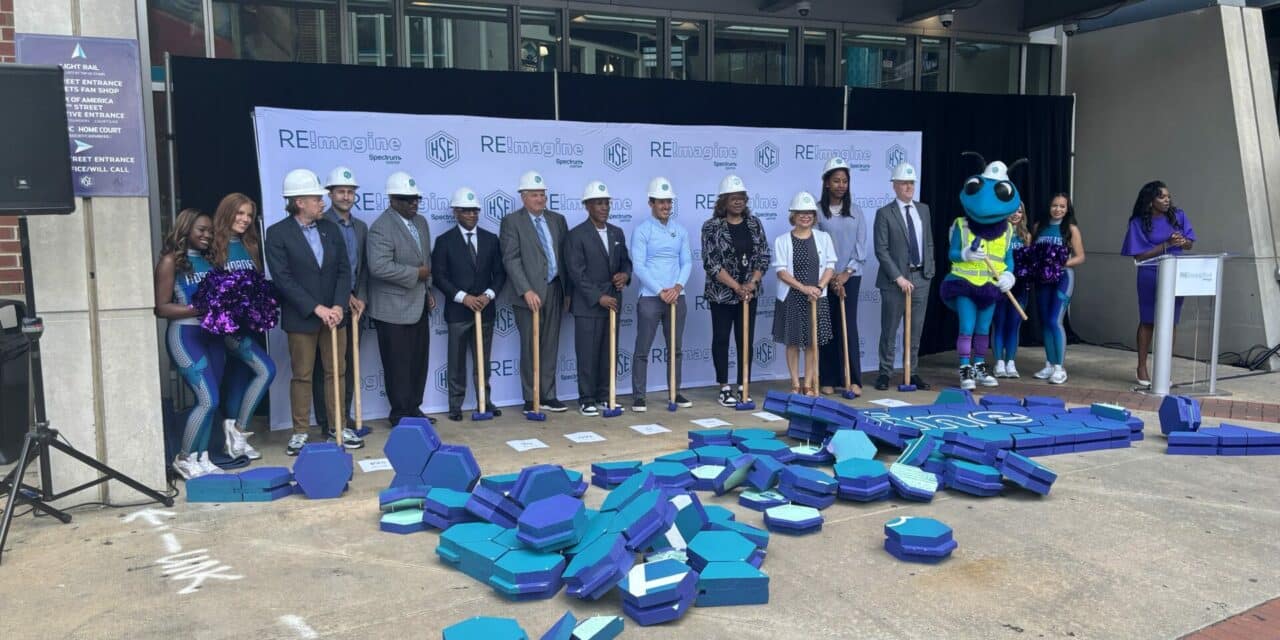TEAR DOWN THIS WALL: Charlotte Hornets officials, including team co-owner Gabe Plotkin, wearing a light blue pullover, and Spectrum Center GM Donna Julian, to his left, celebrate the start of arena upgrades. (Don Muret/Staff)
Project officials hope new practice facility spurs development
CHARLOTTE, North Carolina — The Charlotte Hornets threw a “wall breaking” party on the plaza outside Spectrum Center on Monday to kick off of a two-year renovation of the 19-year-old NBA arena.
The project has been five years in the making for the NBA team, as well as CAA Icon senior vice president Shaun Mason, whose firm serves as the owner’s representative for the $245 million redevelopment.
Joe Dyer, an associate principal with Perkins & Will, the project architect, has been involved since 2020. That’s almost as long as Mason and his crew from Icon, which has grown its presence in Charlotte to about 20 people, a half-dozen of which are working on Spectrum Center. On his own, Dyer helped work on the initial concept design before the project was officially awarded to Perkins & Will.
Both were in attendance at the celebration and shared their thoughts with VenuesNow prior to the first phase of construction, which shuts the arena down until Oct. 2, when it reopens for the Aerosmith/Black Crowes concert.
They’ve studied the city-owned facility inside and out over the past five years to determine the weak spots for a building that sits on a tight footprint in uptown Charlotte.
One shortcoming that doesn’t get a whole lot of media attention are the mostly empty storefronts tied to the arena, situated along Trade Street, across the street from the Charlotte Transportation Center. When Spectrum Center opened as Charlotte Bobcats Arena in 2005, the city and the old NBA Bobcats touted those retail spaces as a plus to draw non-gameday business to the arena.
Things didn’t turn out exactly the way they envisioned for those storefronts facing the transportation center, which has been subject to a high crime rate over the past several years. In mid-November, as the Iowa-Virginia Tech women’s basketball game took place at Spectrum Center before a record crowd of more than 15,000, thousands of whom came to see Caitlin Clark play, a homeless person laid asleep at the base of one storefront.
As construction commences inside the arena, there’s a plan to create a stronger connection between the building and the Hornets’ new practice facility proposed for a gravel parking lot behind the arena, which in turn, could potentially spur more development, including the Spectrum Center storefronts, according to Mason and Dyer.
Mason said it’s ultimately up to the city to drive further business adjacent to Spectrum Center, but he feels the practice facility and clinic will help spur new retail in those empty storefronts. At least that’s what the Hornets hope will materialize, he said.
“We’re moving full steam ahead and looking forward to having the (arena and practice facility) play off each other,” Mason said.
The original concept for the new practice facility was to build it where the transportation center stands, using $60 million in public money, and relocate the center underground, beneath its current site. In February, that idea was scrapped in favor of the new site, which emerged after the city revised its plan to finance arena upgrades and the new practice facility and the funding package. The city increased the total amount to pay for Spectrum Center renovations to $245 million and reduced its contribution for building the practice facility to $30 million.
In turn, the Hornets committed to funding construction of the practice facility above the city’s share, with the team responsible for paying the balance of that project. By comparison, the cost to build three of the NBA’s newest practice facilities in Atlanta, Detroit and Orlando ran $50 million to $90 million. CAA Icon is also the Hornets owner’s rep for the proposed practice facility, in which the team’s healthcare partner Novant Health plans to incorporate a sports medicine and orthopedic clinic, similar to what other NBA teams have done with local hospitals.
From the architect’s perspective, the strategy is to create more activation outside the arena by expanding entry points at the corner of Trade and Caldwell, near the practice facility, Dyer said. There’s currently an entrance reserved for suite holders in that vicinity. The renovations call for greater access to general admission seat holders to enter the arena on the east side with direct stair circulation up to the concourse.
“It will be a lot more prominent as you come in,” he said. “They do a little bit of that now, but through the egress stairs. When this arena was built, egress was a focus, but now, ingress is just as important, and with the way security is tighter now, you have have to make sure you’re factoring that wait time into the equation.”
In the arena’s early years, Dunkin’ Donuts, a pizzeria and a bike shop were among the venue’s street side businesses, but over time, most of them went away, leaving a barber shop as the lone tenant. The general contractor for the Spectrum Center renovations, a joint venture between Turner Construction and local firm D.A. Everett, currently occupies one of the storefronts as its construction office for the next two summers.
It’s not all bad. Over the past dozen years, there has been some new development next to Spectrum Center, such as the Hyatt House hotel and an all-night diner that in 2022 relocated to Trade Street near the transportation center.

FILLING SPACE: The joint venture of Turner Construction and D.A. Everett occupies one of Spectrum Center’s empty storefront during the arena’s two-year renovation. (Don Muret/Staff)
Inside the arena, the biggest drawbacks are a sit-down restaurant that’s hidden from view, for both the fans trying to find it and their line of sight to the event floor; tiered loge boxes at stage end that are blacked out for concerts and one of the largest and steepest upper bowls in the NBA.
There’s not much the Hornets can do to minimize the rake of the upper deck, but by introducing general admission platforms, similar to the Dr Pepper Pavilion, a 1,000-person standing room space in the upper deck and which was part of the original arena design, it creates something different than a standard nosebleed seat, whether it’s temporary or permanent, Mason said.
By replacing the loge box products at stage end — which are in low demand for Hornets games and typically discarded from the manifest for concerts — with 2,500 general admission seats, it will help reduce the large disparity in seating between the lower and upper bowls, Dyer said.
Depending on how things shake out, the ratio will stand at about 50-50, with 10,500 seats in the upper bowl and about the same number in the lower bowl for Hornets games, creating more desirable location with the multiple new premium spaces planned for the lower bowl.
As it stands now, the split is 65-35 in favor of the upper bowl, Dyer said.
The upgrades extend to the Flight Deck, the arena restaurant, which sits on the Founders Level, midlevel in the bowl. The blueprints extend to creating more direct access for all ticket holders to the restaurant by reworking the middle bowl and providing vomitory and aisle access from the main concourse to the Founders Level.
“That was one of the big ideas coming out of this project,” Dyer said. “There’s always been access, but not a lot of people know where the restaurant exists; it’s hard to find.”







